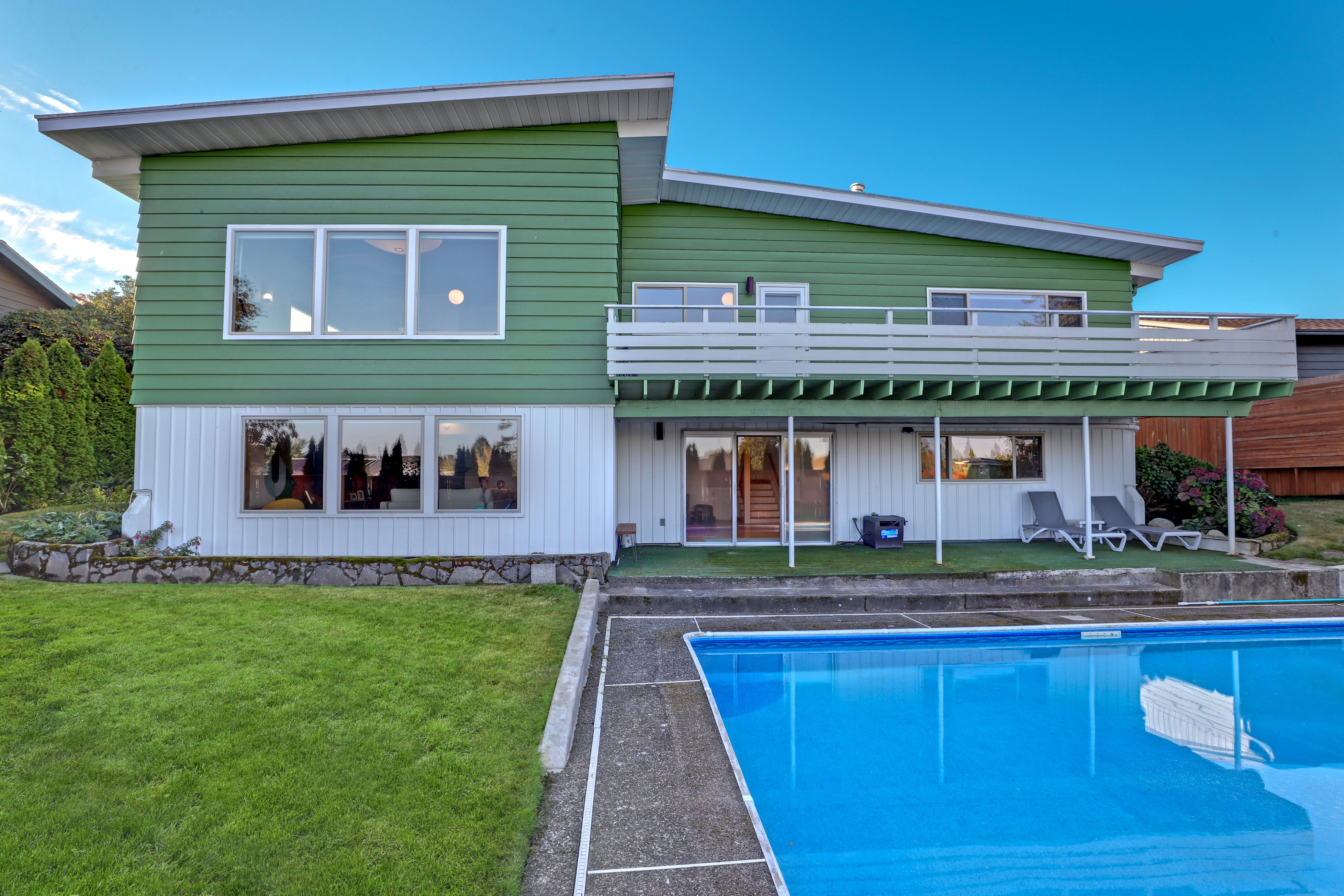Coming of Age
YOU MAY KNOW PACIFIC PALISADES as the salacious setting of Aaron Spelling’s 1997 TV series of the same name—a lust- and greed-ridden black hole of suburban Los Angeles philistinism. It made for great entertainment (for some viewers, at least). But to Kelly Zahoudanis and her husband, Alexis, Pacific Palisades was a real place. It was their home, where they spent the last 3 years of a 12-year stint in Los Angeles.
“And then we were just done,” says Kelly, with a matter-of-fact flick of her wrist. A ginger-haired former real estate agent, Kelly, 34, shows me around her family’s new Southwest Portland split-level. She’s barefoot and dressed in sweats, the uniform of her new job as a stay-at-home mom. “We wanted a change of lifestyle,” she says, “a place with values and ideals in line with ours.”
Nowhere is less La-La Land than Portland, of course—a city that inspires not prime-time soaps and sitcoms, but treatises on civitas. So last February, Kelly and Alexis, a commercial-property developer, flew north. Over five cold, rainy days, they explored the Portland heartland, spending the majority of their time in those neighborhoods near downtown that proffer coffee shops on every corner and bike lanes on every street, hoping to claim their own little piece of wholesome Cascadian nirvana.
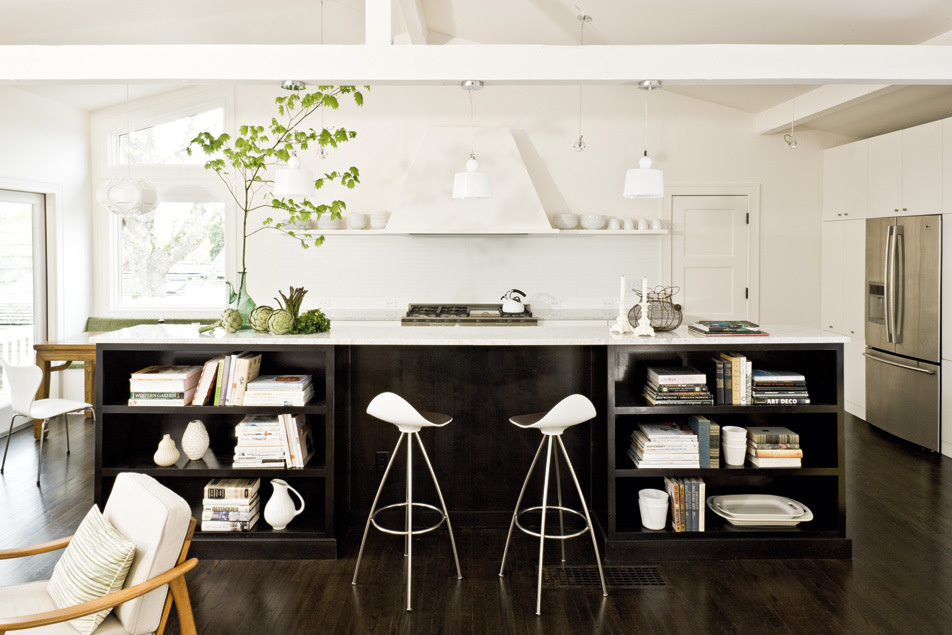
The kitchen, with a range hood-and-shelf combo designed by Jessica Helgerson.
Instead, after slogging through what felt like every Irvington Victorian, Laurelhurst Craftsman, and Westmoreland foursquare on the market, Kelly and Alexis found themselves missing their home. Specifically, the flowing spaces of their midcentury-modern California ranch, a design that is rare to nonexistent in Portland’s close-in historic districts. “We were somewhat charmed by all those Portland-style bungalows,” Kelly recalls, “but the floor plans weren’t conducive to open family living.”
Moreover, Kelly and Alexis weren’t sure they actually needed a coffee shop within walking distance of their house. After all, their real objective was to slow their lives down, find some peace and quiet, and give their toddling boys, 4-year-old Jack and 2-year-old Peter, plenty of room to play. Maybe they really did want to live on a cul-de-sac—just one without the dead-end suburban values they’d fled.
Midway through the house-hunting trip, Kelly and Alexis drove with their real estate agent through the looping streets of Southwest Portland’s Bridlemile neighborhood, which is close to the border of Washington County, near Raleigh Hills. The planned midcentury development was, Kelly says with a mix of irony and genuine admiration, a place where the Cleaver family would have felt perfectly at home. And the rambling 1959 split-level they’d come to see actually held some promise.
The living space centered around an open great room, which was located on the main floor; a spacious upper-level master suite; and a daylight basement with three bedrooms and, perhaps most appealing, a sprawling rumpus room where Jack and Peter could spread out their toys. Furthermore, the 14,000-square-foot property was about triple the size of the standard inner-city lot. There was a parklike backyard for the boys to play in, and also a broad, sunny, south-facing deck, where mom and dad could supervise the action—demitasses of homemade espresso in hand, if they so desired.
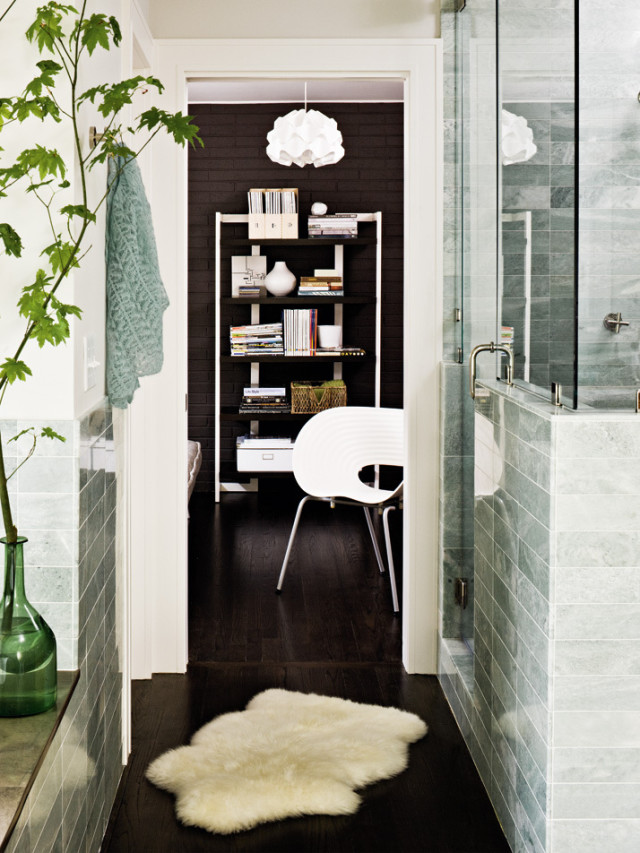
Pale-green stone tile gives the master bath, which connects to the main bedroom and the study, a peaceful, spalike feel.
Kelly and Alexis made an offer on the house, which was soon accepted, and promptly headed back to Pacific Palisades, where Kelly immediately set about Googling Portland-based interior designers. Though the couple was delighted with their purchase, the house had some considerable cosmetic deficiencies—not the least of which were the battleship-gray exterior paint job and an overly narrow front door. Kelly hoped to get these things in shape before they moved in.
The contemporary looks on the website of interior designer Jessica Helgerson, who had moved her business to Portland from Santa Barbara four years ago, appealed to Kelly, and over the phone, Kelly says, the two women “clicked.” Kelly e-mailed Helgerson images she’d clipped from magazines and then arranged for her real estate agent to meet the designer at the house.
Helgerson’s response to the home (as Kelly’s agent casually mentioned to the Zahoudanises a few weeks later) was a mixture of horror and dismay.
“The house was such a dog,” Helgerson recalls with a guilty laugh. “It had all these small vinyl windows. The kitchen was super-cramped. Inside, everything was mauve.” Fortunately, the Zahoudanises were in full accord with Helgerson’s criticisms.
Everyone concurred that the two biggest problems with the house were the kitchen and the master suite. The galley kitchen was poorly situated along the house’s front (north) side, and it was enclosed by an interior wall that cut off the main living area both from light and from views of the front yard. Meanwhile, the master suite was a mess, with a narrow, elongated bedroom and what Kelly remembers as a “teeny, disgusting bathroom with a tan, rubber floor.”
To fix these quirks, Helgerson suggested transforming one end of the excessively long master bedroom into a luxurious master bath and then downgrading the former bathroom into a more appropriately scaled walk-in closet. The kitchen could be flipped 45 degrees so that it would hug the adjacent (west) exterior wall of the house and flow directly into the great room. Consequently, the home’s front (north) wall would open up, allowing Helgerson to install windows there that would let in more light and look out onto a new deck, outfitted with built-in planter boxes, that Helgerson’s husband, architect Yanni Doulis, agreed to design.
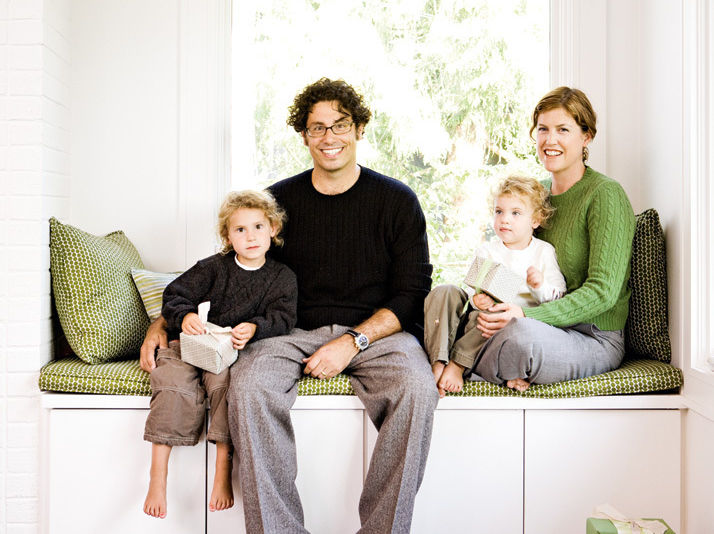
The Zahoudanis family: (from left) Jack, Alexis, Peter, and Kelly.
Go for it, said Kelly and Alexis. They also approved less radical improvements—like tearing down the faux-Colonial, painted-wood fireplace mantel in the great room so that the home’s original, minimalist brick hearth would be exposed; swapping the flimsy hollow-core interior doors for solid wood ones; and replacing the retro “clamshell” window and door trim with a more subdued, rectilinear design.
“I try to do the thing that really seems right for the house,” says Helgerson of her design sensibilities, “to be accurate from a period perspective, and to attend to how the house is going to flow and function.” But once that’s accomplished, “portable” things like wall coverings, furnishings, light fixtures, and art “can go in a completely different direction,” she adds.
Ergo, bold arboreal-motif wallpaper in the main-level powder room; a dazzling mirrored cabinet on the prominent upper stair-landing; and an array of fun light fixtures hanging throughout the house, including a curvaceous Le Klint pendant and industrial-chic, hanging glass blobs made by Niche Modern. From the planks of a sugar maple—a Portland street tree that had been felled—Doulis designed and built a coffee table, which now serves as the living room’s centerpiece.
These days, Helgerson revisits her handiwork often, since she, Doulis, and their kids have become good friends with the Zahoudanis clan. Post-remodel and redecoration, it’s hard to believe this beautiful house was ever a “dog.” Or, for that matter, that Kelly and Alexis Zahoudanis ever would have chosen the Santa Monica Freeway fast lane over their 25-mile-per-hour Southwest Portland loop.
“It’s surreal to like your neighbors so much,” says Kelly of her new, nonphilistinish community. “We have picnics on Thursday nights in the summertime. There’s a woodsy area down the street with a creek and a tree house. The kids run around, looking for worms and stuff, while the parents sit around and drink wine.” If it happens to be California chardonnay on occasion, we won’t tell.
Study in Contrast
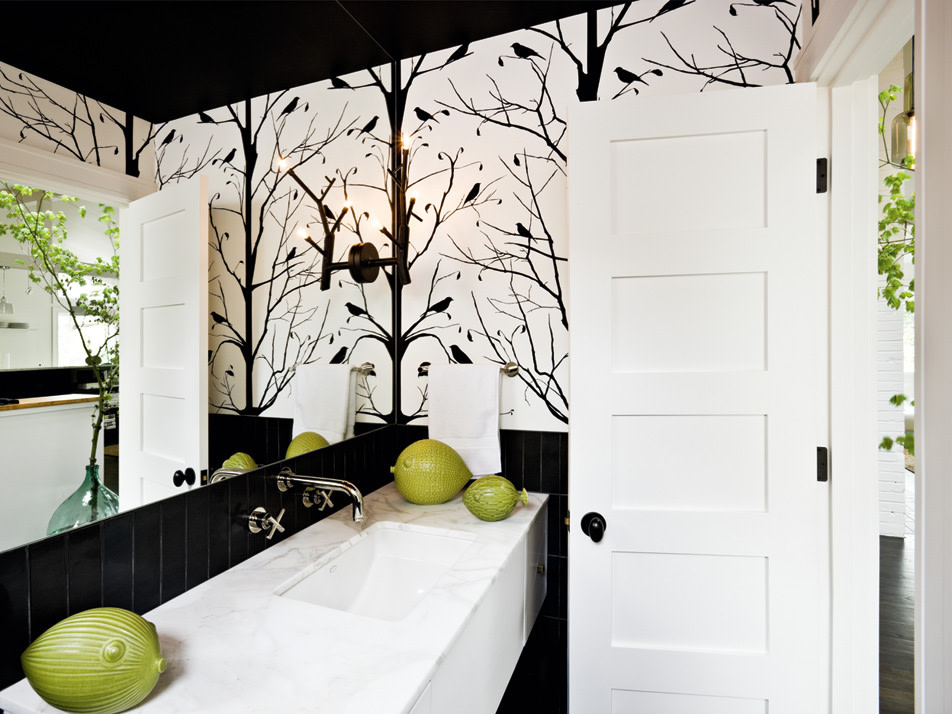
Bright colors aren’t the only way to enliven a drab room. Interior designer Jessica Helgerson chose white paint and ebony-stained floors for the main portion of the Zahoudanis residence. Throughout the home, dark browns, grays, and blacks, which are juxtaposed against pale tints, create a feeling of energy and verve. In the powder room, black paint on the ceiling makes the closet-size space feel more expansive (as a rule, dark colors appear to recede from view), while bold patterned wallpaper turns a primping spot into a forest frolic.
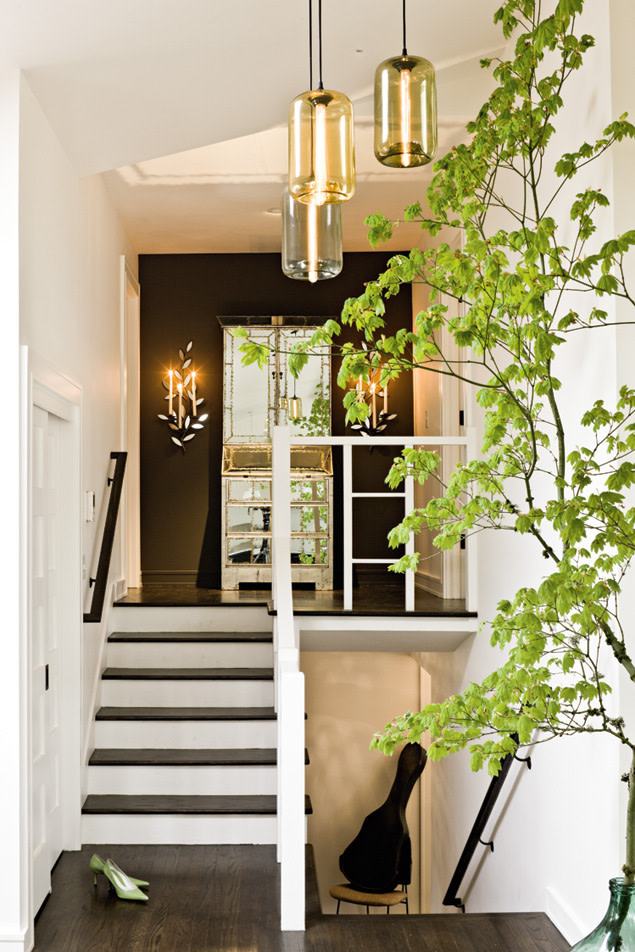
Slate-gray paint transforms a stair landing into a focal point, and also puts the geometric pattern of a white-painted banister in sharp relief. So next time you redecorate, instead of berating yourself for liking brown, just consider upping the cocoa content.
“I like a high-contrast space,” says interior designer Jessica Helgerson, who chose white paint and ebony-stained floors for the main portion of the Zahoudanis residence. “People tend to go for beige, thinking it’s light and safe. It’s much more vibrant to have dark and light, next to each other.”
Throughout the home, dark browns, grays, and blacks, which are juxtaposed against pale tints, create a feeling of energy and verve. In the powder room (above), black paint on the ceiling makes the closet-size space feel more expansive (as a rule, dark colors appear to recede from view), while bold patterned wallpaper turns a primping spot into a forest frolic. Floor-to-ceiling chocolate-brown drapery on the wall behind the headboard endows the master bedroom with a feeling of drama. And slate-gray paint transforms a stair landing (left) into a focal point—and also puts the geometric pattern of a white-painted banister in sharp relief. So next time you redecorate, instead of berating yourself for liking brown, just consider upping the cocoa content.


